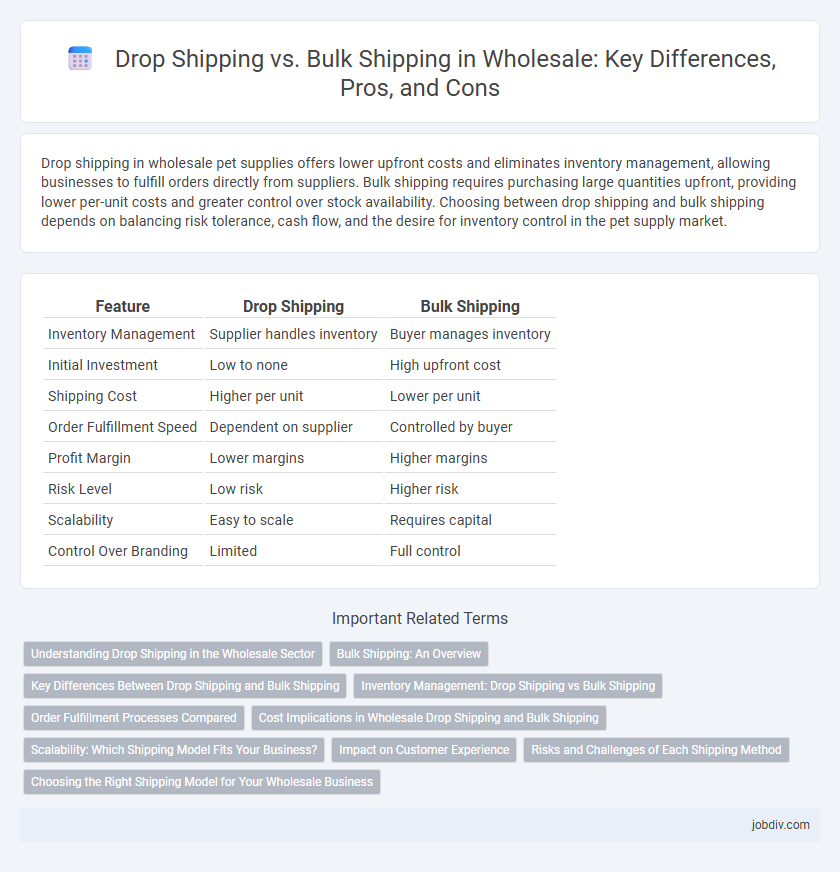Drop shipping in wholesale pet supplies offers lower upfront costs and eliminates inventory management, allowing businesses to fulfill orders directly from suppliers. Bulk shipping requires purchasing large quantities upfront, providing lower per-unit costs and greater control over stock availability. Choosing between drop shipping and bulk shipping depends on balancing risk tolerance, cash flow, and the desire for inventory control in the pet supply market.
Table of Comparison
| Feature | Drop Shipping | Bulk Shipping |
|---|---|---|
| Inventory Management | Supplier handles inventory | Buyer manages inventory |
| Initial Investment | Low to none | High upfront cost |
| Shipping Cost | Higher per unit | Lower per unit |
| Order Fulfillment Speed | Dependent on supplier | Controlled by buyer |
| Profit Margin | Lower margins | Higher margins |
| Risk Level | Low risk | Higher risk |
| Scalability | Easy to scale | Requires capital |
| Control Over Branding | Limited | Full control |
Understanding Drop Shipping in the Wholesale Sector
Drop shipping in the wholesale sector involves retailers selling products without holding inventory, relying on suppliers to ship directly to customers, which minimizes upfront costs and inventory risks. This model enhances flexibility and reduces storage expenses, making it ideal for testing new products or expanding product lines without significant capital investment. Effective management of supplier relationships and shipping times is crucial to maintain customer satisfaction and operational efficiency.
Bulk Shipping: An Overview
Bulk shipping involves purchasing large quantities of products directly from manufacturers or suppliers, enabling significant cost savings per unit compared to smaller orders. This method optimizes inventory management and shipping efficiency, making it ideal for businesses aiming to scale operations and maintain consistent stock levels. Bulk shipping reduces dependency on intermediary logistics, allowing for greater control over delivery timelines and product quality.
Key Differences Between Drop Shipping and Bulk Shipping
Drop shipping involves direct shipment from supplier to customer, minimizing inventory costs, while bulk shipping requires purchasing large quantities and managing storage logistics. Drop shipping offers scalability and reduces upfront investment, whereas bulk shipping provides better pricing per unit and faster order fulfillment. The choice hinges on cash flow, inventory control preferences, and customer delivery speed priorities.
Inventory Management: Drop Shipping vs Bulk Shipping
Drop shipping allows retailers to sell products without holding inventory, reducing storage costs and minimizing the risk of overstocking, but depends heavily on suppliers' stock accuracy and shipping reliability. Bulk shipping requires investing in larger quantities upfront, enabling greater control over inventory levels and faster order fulfillment but involves higher storage costs and the risk of unsold stock. Effective inventory management in bulk shipping demands precise demand forecasting, whereas drop shipping relies on seamless supplier coordination to maintain real-time inventory visibility.
Order Fulfillment Processes Compared
Drop shipping streamlines order fulfillment by directly shipping products from suppliers to customers, minimizing inventory holding and reducing upfront costs for retailers. Bulk shipping involves purchasing large quantities in advance, requiring warehousing and inventory management, which can increase storage costs but improve control over stock availability and shipping times. Efficient order fulfillment in drop shipping relies on real-time supplier integration, while bulk shipping benefits from optimized warehouse logistics and inventory forecasting.
Cost Implications in Wholesale Drop Shipping and Bulk Shipping
Wholesale drop shipping eliminates inventory holding costs but incurs higher per-unit shipping fees and potential supplier markup, impacting overall profit margins. Bulk shipping requires upfront investment in inventory and storage but benefits from lower per-unit shipping rates and economies of scale, reducing the cost per item. Businesses must weigh the trade-off between cash flow flexibility in drop shipping and cost efficiency in bulk shipping to optimize wholesale operations.
Scalability: Which Shipping Model Fits Your Business?
Drop shipping offers unparalleled scalability by allowing businesses to expand product offerings without heavy upfront inventory investments, making it ideal for startups or companies testing new markets. Bulk shipping requires substantial capital and storage capacity but benefits businesses with high demand and predictable sales, enabling lower per-unit shipping costs and improved profit margins. Selecting the right model hinges on your business's growth stage, cash flow, and capacity to manage inventory and logistics efficiently.
Impact on Customer Experience
Drop shipping enhances customer experience by offering a wider product selection and faster delivery through direct shipping from suppliers, reducing inventory risks for retailers. Bulk shipping allows for better control over product quality and packaging consistency, leading to reliable order fulfillment and improved brand perception. Balancing inventory management with shipping speed is crucial in optimizing customer satisfaction in wholesale operations.
Risks and Challenges of Each Shipping Method
Drop shipping poses risks such as limited control over inventory quality and shipping times, increasing the likelihood of customer dissatisfaction and returns. Bulk shipping challenges include high upfront inventory costs and storage requirements, which can lead to cash flow strain and potential stock obsolescence. Both methods demand careful supply chain management to mitigate delays, errors, and financial risks.
Choosing the Right Shipping Model for Your Wholesale Business
Choosing the right shipping model for your wholesale business depends on factors such as inventory management, order volume, and cash flow. Drop shipping reduces upfront costs and storage needs by shipping products directly from suppliers to customers, ideal for businesses with limited capital or testing new products. Bulk shipping offers lower per-unit costs and faster fulfillment for high-volume orders, benefiting established businesses with reliable demand and storage capacity.
Drop Shipping vs Bulk Shipping Infographic

 jobdiv.com
jobdiv.com